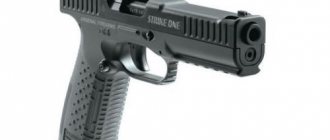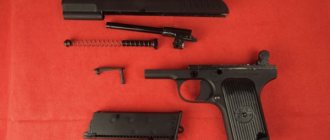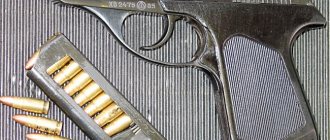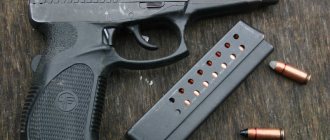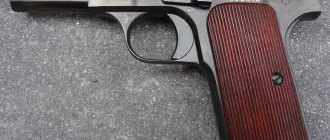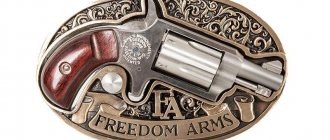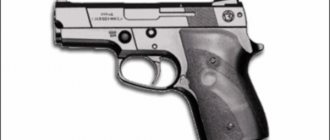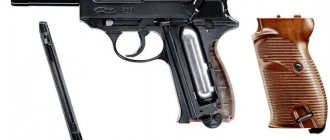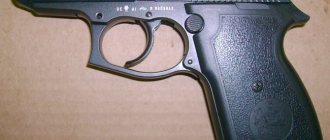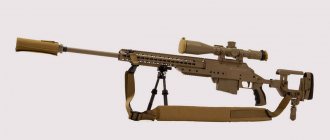The last chance of a sharpie, a businessman and a gentleman is the Derringer pistol.
For New Year, Santa Claus gave me this unusual pistol. Where did the old man learn about my diagnosis (pneumomania)?
True, this is not 4.5mm, but 6mm and not CO2 or even AIR. The gun runs on Green Gas. But the principle is the same. Well, you know.
The pistol has two barrels and two charges, there is no self-cocking, that is, cock, press the trigger, one barrel fires, cock again, press the SC, the other fires. It is impossible to guess which of the barrels will fire at a given moment - this is the design. There is also a fuse - in the photo below it is on the fuse. This lever also opens the barrels for reloading, and if it is moved to the upper position, the pistol goes into firing mode.
There are rubber bands in the barrels that should hold the balls tightly (in fact, I would like to strengthen them somehow - shots are fired from both barrels periodically) and these same rubber bands are pressed tightly against the bypasses - there is no gas leakage in this place.
The pistol is completely hidden in the hand. That's why it was loved by sharpers, businessmen and gentlemen - as a weapon of last chance in disputes, again in a carriage (such a vehicle) one could easily use it to “kill” an opponent. Pistol made in 1830. It was invented by Henry Deringer and produced in his workshop in Philadelphia. Produced in various calibers. Actor John Booth used this 0.44″ (11.2 mm) pistol to kill US President Abraham Lincoln.
Next to 357 Crosman.
Oddly enough, it is quite accurate - I confidently hit this pillar (in the photo below) with one of two shots. I detect the hit by a characteristic metallic hum. It’s quiet in the yard and the slap of the ball on the iron can be clearly heard. The distance is somewhere around 20 meters.
As you can see from the photo, the pistol I received was not entirely new, although the person who gave it to me bought it in a store and bought the last copy (then he carefully asked where he got it from), apparently the sellers had a lot of fun while working.
The abrasions are almost invisible, so I didn’t file a complaint with the store, and I don’t want to upset the person who donated it.
During the very first shootings, doublets were noticed - the balls, when fired, flew out of both barrels at once. Double shots occur either when the pistol has just been filled or when oil gets on the elastic bands that fix the ball.
Therefore, I decided to open the baby and feel his inner world.
On the left (in the frame) is a diagram of the original pistol on the right of its Airsoft brother.
The heads of 7 screws are visible on the pistol, of which there are only 3 screws, the rest are either props or studs designed for screws.
Do not turn the top “screw” with a screwdriver - this is a pin and if you turn it several times, then it will no longer hold on. On the other side of the gun you need to carefully squeeze it out with an awl.
There is also a fake on the handle on this side of the pistol - a false screw cast together with the escutcheon. Don’t touch it at all, it’s a prop, the photo shows that someone in the store tried to unscrew it and damaged the splines. The screw that holds the handles is located on the other side of the pistol.
Also at the end of the handle there are 2 fake screws that do not hold anything, they simply emulate the screws of a real pistol.
The screw between the barrels allows access to the liners and barrel seals. The cartridge ejector, after unscrewing the screw, must be carefully moved outward; it sits very tightly. After removing it, the inner stems along with the elastic bands will fall out on their own. The stems are smooth.
As I already wrote, to get to the gun mechanism you need to unscrew 3 screws and push out 4 studs with an awl. Moreover, the pin holding the barrels (pseudo-screw) does not need to be removed, but the barrels themselves greatly interfere with removing the trigger and the rest of the internals. I took it off so as not to interfere.
Why do I always say “squeeze it out with an awl” - the frame of the pistol and the barrels are made of plastic, you don’t need to apply much force, you can damage the plastic.
Although most of the parts are made of plastic, the pistol has a pleasant weight, the right grip pad is made of metal and the gas tank located on the left pad is also quite heavy and all this together gives 220 grams. The real one weighed 340 grams.
When unscrewing the lever that opens the barrels, be careful - there is a spring under the screw.
After unscrewing the screws and removing the pins, the entire mechanism must be carefully squeezed out of the frame towards the barrels.
View from the inside of the handle to the entire interior.
Everything has been extracted.
Frame from different sides.
The trigger and gas distribution mechanism are assembled into a single unit that can be easily disassembled.
Gas distribution unit with turntable.
The gas distribution unit is disassembled.
As you can see, the pinwheel has a transverse wall. And when turning, it switches the gas flow either to one channel or to another.
And due to the design of this entire assembly, there are gaps between the channels in any position of the turntable. And gas leaks occur into the currently inoperative barrel. And hence the double shot.
So far there are no ideas on how to seal this knot.
The only idea I came up with was to slightly increase the rigidity of the bypass rubber bands and then the ball should not fly out of the closed barrel.
You can compress it by wrapping it tightly with thread.
Assembly occurs in reverse order.
You assemble the gas distribution unit (not forgetting the two rubber seals), install the trigger on it, connect everything with a pin and carefully push it into the body, the only thing is that the trigger must be inserted with the gas distribution unit almost completely inserted.
Again, secure everything with pins.
The rest is generally assembled with your eyes closed.
The gun has some kind of attractive force - you don’t want to let it go at all. It is not without reason that it continues to be produced from 1830 to this day and there are many variations of it.
Santa Claus got the gift right 100%!
The formation of conducting art
With the development of symphonic music, its content became more complex and its means of expression were enriched. The former leader, who played in the ensemble and at the same time gave instructions to the musicians, could no longer carry out the complex and diverse functions of managing the orchestra.
The task of fully realizing a symphonic work with its multi-colored instrumental structure, large scale and features of the musical form has put forward the requirements of a new technique - the art of conducting.
By the middle of the 18th century, the functions of the leader passed to the musician, who did not directly participate in the ensemble playing. It is believed that the first conductor to stand on a special platform was Johann Friedrich Reichardt (1752-1814).
Already at the beginning of the 19th century, conducting became an independent form of performing art. Composers who performed successfully in this field (Weber, Mendelssohn, Berlioz, Liszt, Wagner) put forward a new requirement for the orchestra leader: the conductor is a professional.
Gradually, a new method of conducting was established, which has survived to this day. The conductor faces the orchestra, and not the audience (Richard Wagner was the first to do this), and controls the orchestra with the help of a baton (priority in this area belongs to the German violinist and composer L. Spohr).
The Rise of the Art of Conducting
The real rise of conducting art occurred at the end of the 19th century. A galaxy of talented conductors appeared on the world musical arena: G. Bülow, F. Weingartner, G. Mahler, A. Nikisch, F. Mottl, G. Richter, R. Strauss.
Their traditions were preserved and enhanced by conductors of the 20th-21st centuries - A. Toscanini, E. Ansermet, O. Klemperer, O. Fried, B. Walter, W. Furtwängler, V. Talich, G. Georgescu, G. Wood and others.
The brilliant achievements of the Russian conducting school were demonstrated by composers M. Balakirev, A. Rubinstein, S. Rachmaninov. P. Tchaikovsky, N. Rimsky-Korsakov, A. Lyadov, N. Rubinstein, V. Safonov, F. Blumenfeld, E. Napravnik successfully performed as conductors. The Soviet music and performing culture also produced a cohort of outstanding conductors. Among them are N. Golovanov, S. Samosud, A. Gauk, E. Mravinsky, O. Dimitriadi, E. Svetlanov, G. Rozhdestvensky.
